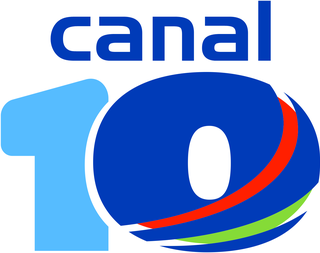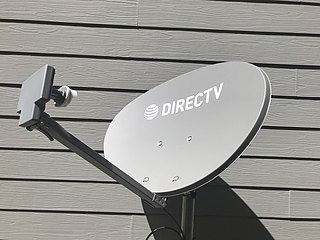In most telecommunications organizations, a virtual channel is a method of remapping the program number as used in H.222 Program Association Tables and Program Mapping Tables to a channel number that can be entered via digits on a receiver's remote control.

TV+ is a Chilean free-to-air television channel. which is broadcast from Santiago. Previously known as the Television Corporation of the Pontifical Catholic University of Valparaíso or UCV Televisión, it was the oldest television station in the country and the only regional network outside of Santiago that had nationwide coverage. It started broadcasting on an experimental level in the Pontifical University of Valparaíso's buildings in 1957 and was officially launched in August 1959. In 2017, it moved its offices to the Agua Santa district in Viña del Mar.

Telecanal is a private owned TV channel of Chile, launched on December 5, 2005. It currently airs in Santiago on VHF channel 2. The station for the channel mostly airs American films and TV series.
XHTVM-TDT is a television station in Mexico City, owned by Televisora del Valle de México and operated by TV Azteca. It is branded as adn40 and available over the air in much of Mexico on TV Azteca's transmitters. Programming generally consists of news and informational shows.

Canal 2 is a Nicaraguan free-to-air television network owned by Televicentro de Nicaragua, S.A.
Vos TV, formerly ESTV, was a Nicaraguan cable TV channel broadcasting from the city of Managua and owned by Grupo Pellas. Before it was assigned a terrestrial frequency, it was known as ESTV and ran exclusively on ESTESA's cable network.

Canal 10 is a nationwide terrestrial television channel from Nicaragua owned by Radio y Televisión de Nicaragua, S.A. (RATENSA), a company founded by Mexican investors.

Canal 4 is a state-run nationwide terrestrial television channel in Nicaragua owned by Informativos de Televisión y Radio S.A. (Intrasa), a company owned by two sons of Daniel Ortega, Carlos Enrique "Tino" Ortega and his brother Daniel Edmundo. Until 2007, Remigio Ángel González of Albavisión owned 94% of the channel's assets, after that, the Ortega-Murillo regained control.
Enlace Nicaragua is a Christian television channel in Nicaragua, part of the international Enlace TBN network. It broadcasts on UHF channel 21.

Satellite television is a service that delivers television programming to viewers by relaying it from a communications satellite orbiting the Earth directly to the viewer's location. The signals are received via an outdoor parabolic antenna commonly referred to as a satellite dish and a low-noise block downconverter.

Television in the Philippines was introduced in October 1953 upon the first commercial broadcast made by Alto Broadcasting System, making the Philippines the first Southeast Asian country and the second in Asia to do so. Even before that, during the late 1940s, a number of academic experiments had been done and replicated by Filipino engineers and students.

Sonshine Media Network International (SMNI), also known by its legal operating name Swara Sug Media Corporation, is the official broadcasting arm of the Kingdom of Jesus Christ (KJC) led by the Filipino televangelist Pastor Apollo C. Quiboloy.

A broadcast relay station, also known as a satellite station, relay transmitter, broadcast translator (U.S.), re-broadcaster (Canada), repeater or complementary station (Mexico), is a broadcast transmitter which repeats the signal of a radio or television station to an area not covered by the originating station. It expands the broadcast range of a television or radio station beyond the primary signal's original coverage or improves service in the original coverage area. The stations may be used to create a single-frequency network. They may also be used by an AM or FM radio station to establish a presence on the other band.

Television in Colombia or Colombian television is a media of Colombia. It is characterized for broadcasting telenovelas, series, game shows and TV news. Until 1998 it was a state monopoly. There are two privately owned TV networks and three state-owned TV networks with national coverage, as well as six regional TV networks and dozens of local TV stations. There are numerous cable TV companies operating in Colombia under each Colombian department statutes. These cable companies also develop their own channels, in addition to a variety of international channels. Television in Colombia has always relied on technological advancements from developed countries importing almost all the equipment.
Television in Spain was launched on 28 October 1956, when the national state-owned public service television broadcaster Televisión Española (TVE) started regular analog free-to-air terrestrial black and white broadcasts. Colour transmissions started in 1972 after two years of test transmissions, with all programming transmitted in color in 1977, and colour commercials starting in 1978. TVE held a monopoly on television broadcasting until regional public channels were launched during the 1980s and commercial television started nationwide in 1990. Digital terrestrial television was launched on 30 November 2005 with analog service discontinued on 3 April 2010. Currently, television is one of the leading mass media of the country, and by 2008 was in 99.7% of households in Spain according to INE statistics.
Remigio Ángel González is a Mexican-born owner of the Latin American media network Albavisión. He has lived in Miami since 1987. The network is named for his wife Alba Elvira Lorenzana, who is from Guatemala. González was estimated to be worth $350m in 2002, and by some accounts is now worth $2bn. González has a conservative political stance, but he aims to keep a low profile and cooperate with host country governments. As part of this strategy, he is said to have modified the editorial lines of his stations, particularly in Guatemala and Nicaragua, to accommodate government preferences.
TV Red is a nationwide terrestrial television channel from Nicaragua owned by Ángel González. TV Red began broadcasting in August 2010, up until then channel 11 on Claro TV was occupied by VosTV.
Television in Peru has a history of more than 60 years. There are 105 television broadcasters in Peru, 22 of which are in Lima. In regard to television receivers, in 2003 there were 5,470,000 — that is 200 televisions for every thousand inhabitants. The number of cable subscribers was 967,943 in 2011.

Viva Nicaragua is a television station on channel 13 in Nicaragua. The channel also airs a mix of domestic and international programs, mainly consisting of news, lifestyle and sports programming, along with imported programming consisting of films, children's programs and drama series.

Canal 6 is a Nicaraguan terrestrial television channel broadcasting from the city of Managua. The station claims to be owned by the Government of Nicaragua, but is actually owned by a joint stock company called NEPISA












